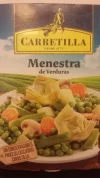I think that the advice for thru-hikers is probably overkill for the Camino. Although the Camino is a long walk, it is far from a thru-hike. I think the longest stretch between towns on the
Camino Frances is 17km. There's plenty of food available, and most of the time the variety is pretty good. Sometimes Pilgrims Menus get a little tiresome, but that is rarely the only choice, except in some small villages.
I don't think getting enough protein is an issue - it's Spain, they put meat in everything. Vegetarians will have to work a little harder to make sure they get enough from non-meat sources, but if you are a meat eater, then it's easy. Every ensalada mixta (mixed salad) comes with tuna on it. Lentejas (lentil soup) will be cooked with a ham hock, and probably chorizo. Grilled meat is on almost every menu. Spanish tortilla is ubiquitous - made of egg and potato, sometimes some kind of meat too. And then there's all the delicious cured meats.
For electrolytes, there are gatorade-type drinks available - Aquarius is a popular one, but has less sugar than gatorade. And there are electrolyte tablets in the pharmacies that you can add to your water if you find that you aren't replenishing your minerals with your food.






















